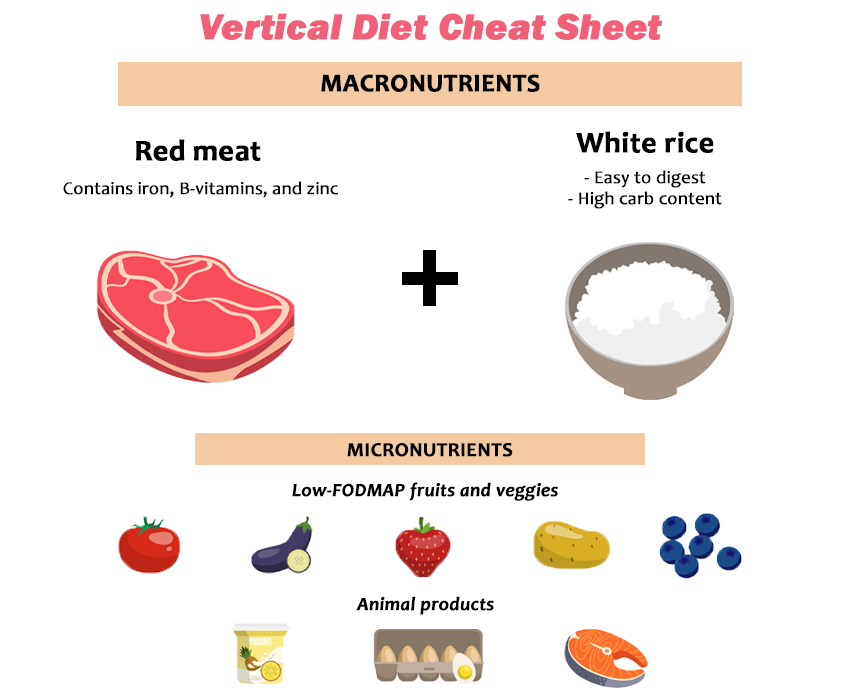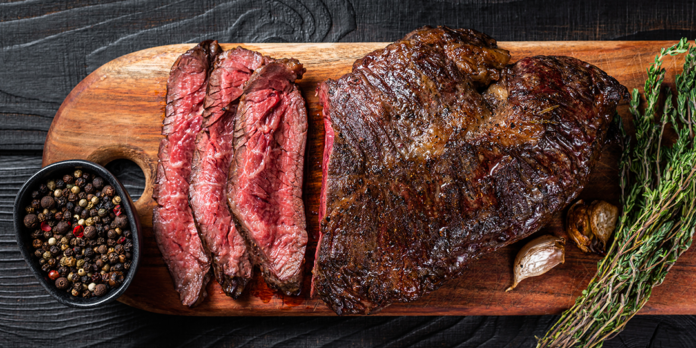Created by professional bodybuilder and powerlifter Stan Efferding, the vertical diet claims to improve athletic performance and body composition. While initially developed for high-level athletes, it’s now gaining traction with average gym-goers, too.
It should be noted that there’s not much research to back up its founder’s claims. Many athletes and bodybuilders, as well as regular gym rats, do just as well or better on a more balanced diet. There are also some groups of people that should be avoiding the vertical diet altogether (more on that later).
Why Is It Called the Vertical Diet?
To understand the vertical diet, it’s important to understand what a “horizontal diet” is.
On a horizontal diet, you focus on consuming a wide variety of nutrient-dense foods from numerous food groups, such as fruits, vegetables, grains, legumes, and protein. In a sense, this diet encourages you to “eat the rainbow” and consume a variety of nutrients that are unlikely to all be represented in a single food group.
The vertical diet is the opposite. Instead of combining foods from across many groups, you consume large amounts of just a few foods that are relatively easy to digest. By following this diet, you’d simplify planning meals, meeting energy needs, and absorbing nutrients.
While the vertical diet may be effective for certain groups of people, such as those who have particular gastrointestinal conditions, there’s no research to support the same benefits for anyone else.
How Do You Follow the Vertical Diet?
If you’re planning to follow the vertical diet, it’s essential to understand that some foods are not allowed. This diet encompasses a variety of restrictions and follows some rules from the low-FODMAP diet. (FODMAP stands for fermentable oligosaccharides, disaccharides, monosaccharides, and polyols, which are a specific group of carbs that are poorly absorbed in your gut and may aggravate digestive issues.)
Once you understand the rules, you rely on calorie-counting to ensure you are eating in a caloric surplus to facilitate muscle gain. So, if you’re focused on weight loss, the vertical diet isn’t for you.
Let’s look at some of the basics of the vertical diet.
Who May Want to Follow the Vertical Diet?

This diet is marketed towards people who are looking to build muscle and “get jacked.” It helps to simplify the process of getting a lot of calories quickly and easily. It also makes it relatively simple to track and modify your macronutrient intake, so it’s easy to level it up or down.
The vertical diet might be useful for athletes and bodybuilders, who are carefully monitoring their food intake and progress and may need to make adjustments regularly. Health-wise, the diet would be okay for a young, healthy individual who is focused on muscle growth, since they can withstand the impact of a high quantity of beef and rice while still getting nutrients from the side foods.
However, you can also learn to track and modify your intake while consuming a wider variety of foods with fewer restrictions and plenty of benefits. This could be more cost-effective and enjoyable.
Who Should Avoid the Vertical Diet?
The vertical diet is not recommended for those who are:
- Susceptible to heart issues
- Eating a moderate amount of calories
- Looking to lose weight
Given its focus on red meat intake, it’s also not appropriate for those who have a family history of colon cancer, as high intakes of red meat have been linked to higher rates of this particular cancer. Additionally, since white rice has a high glycemic index (i.e. it can make your blood sugar levels rise quickly), this wouldn’t be a good choice for those looking to manage blood sugar levels, such as diabetics.
Foods You Eat On the Vertical Diet
The bulk of your caloric intake on the vertical diet is supposed to come from two sources:

Efferding chose white rice for its easy digestibility and high carbohydrate content and red meat for its iron, B-vitamin, and zinc content.
The vertical diet also allows for a variety of “micronutrient” foods that include:
- Low-FODMAP vegetables (including tomatoes, kale, sweet potatoes, and eggplant)
- Low-FODMAP fruits (blueberries, strawberries, and unripe bananas)
- Animal products like eggs, broth, whole-fat dairy, and fatty fish
- Legumes and oats, but only if they are soaked and fermented
Foods to Avoid On the Vertical Diet
Foods to avoid include:
- High-FODMAP vegetables (which include asparagus, brussels sprouts, and cauliflower)
- High-FODMAP fruits (including apples, cherries, and watermelon)
- Grains
- Legumes
- Sugar or sugar alcohols
- Processed vegetable oils
Coffee and alkalized water are also not permitted on the vertical diet.
Benefits of the Vertical Diet

It may help build mass
The main focus of the diet is building muscle mass easily and quickly. This would do the trick for young gym-goers, but it’s probably not very sustainable over the long term.
It may be useful for those with food sensitivities
The diet focuses on consuming low-FODMAP foods, which may be easier to digest for those with food sensitivities. However, in the medical setting, the low-FODMAP diet is intended for short-term use, with the intention of reintroducing certain foods back into the diet later on.
In addition, the low-FODMAP nature of the diet eliminates prebiotics that feed the probiotics that make up the microbiome, which can further impact overall gut health, says registered dietitian Cordialis Msora-Kasago.
Downsides of the Vertical Diet
While some people might experience desirable results from the vertical diet, there are a couple reasons why many others won’t find the same success.
It’s restrictive
Efferding claims that consuming fewer kinds of foods is optimal for digestion and nutrient absorption, which results in improved body composition, gut health, and metabolism. However, these claims are not all backed by science.
Following restrictive diet approaches can result in nutrient deficiencies and potential gut health issues. Research suggests that the gut might function best with a variety of different nutrients.
It might be difficult to follow
“While the vertical diet may help the bodybuilder eat enough food to pack on muscle mass without experiencing signs of gastrointestinal discomfort, it is certainly not an approach that most people can sustain,” says Msora-Kasago. “It limits so many foods and can get expensive.”
She adds that for sustained results, the key factors are variety, accessibility and affordability. “Start with the foods that you like and identify the opportunities in your personal eating patterns,” she says. “Oftentimes, it is the small changes we make that yield the biggest results.”
The Final Verdict On the Vertical Diet
Overall, when it comes to dieting, there is no one-size-fits-all approach. The vertical diet is restrictive and unrealistic for many people, and there are plenty of other ways to pack on muscle that are both more flexible and enjoyable.

